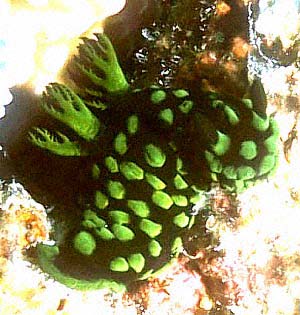
Nembrotha cristata
Bergh, 1877
Order: NUDIBRANCHIA
Suborder: DORIDINA
Family: Polyceridae
Subfamily: Nembrothinae
DISTRIBUTION
Tropical Indo-West Pacific.
PHOTO
Lizard Is, North Queensland, November 1974.
Similar in size and colour to Nembrotha kubaryana, its main point of difference is the green border to its foot. It also feeds on a green compound ascidian which Willan & Coleman (1984) identify as Eudistoma olivaceum. Perhaps this is a biological difference from Nembrotha kubaryana, which is shown feeding on a blue solitary ascidian.
Reference:
• Bergh, L.S.R. (1877). Malacologische Untersuchengen. In C.G. Semper, Reisen im Archipel der Philippinen, Wissenscaftliche Resultate, 11: 429-494, pls 54-57
Rudman, W.B., 1999 (January 21) Nembrotha cristata Bergh, 1877. [In] Sea Slug Forum. Australian Museum, Sydney. Available from http://www.seaslugforum.net/find/nembcris
Related messages
Re: Nembrotha cristata from Indonesia
September 25, 2009
From: David Sifre
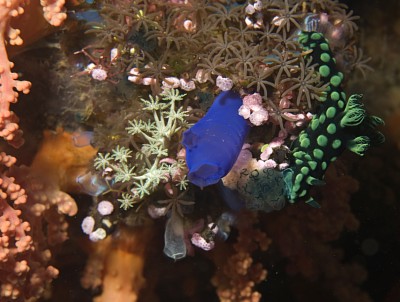
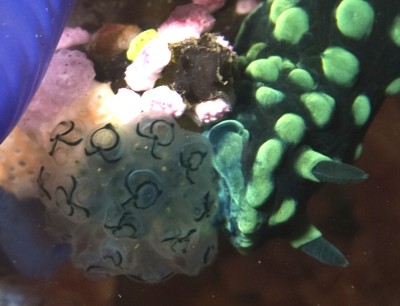
Concerning message #7484:
Here is one I photographed by accident (ashamed to admit it, but I was taking a picture for the colors and did not realize I had a critter in the frame until I got home!). Looks like it is eating, so perhaps it will help you with behaviors.
Locality: Indonesia (near komodo), Komodo Indonesia, 10 August 2009, Black Magic dive site. Photographer: David Sifre.
David Sifre
dsifre@gmail.com
Sifre, David, 2009 (Sep 25) Re: Nembrotha cristata from Indonesia. [Message in] Sea Slug Forum. Australian Museum, Sydney. Available from http://www.seaslugforum.net/find/22616
Dear David,
It is amazing how many interesting 'things' are first found in photos. When we are looking at the 'big picture' we often miss some of the bits that make it up. There are a number of ascidians in your photo, including the spectacular bright blue one, but when we look closely, your Nembrotha cristata is interested only in the dull green Sigillina signifera, which from earlier messages [#7188, #19177] seems to be its main food item.
Thanks for the photo. It is a valuable addition to our knowledge.
Best wishes,
Bill Rudman
Nembrotha cristata from Malaysia
April 22, 2008
From: Bruce Paggeot
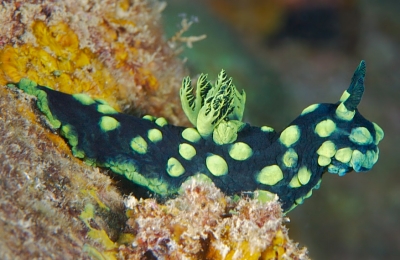
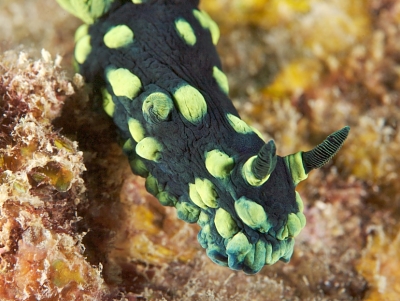
Heres a few pics of Nembrotha cristata. It is rearing in a couple of the photos.
Locality: Tioman, 9 Meters, Malaysia, South China Sea, 15 September 2007, Rocky reef. Length: 2 inches. Photographer: Lisa Paggeot.
Lisa Paggeot
bruce@paggeot.com
Paggeot, B.M., 2008 (Apr 22) Nembrotha cristata from Malaysia. [Message in] Sea Slug Forum. Australian Museum, Sydney. Available from http://www.seaslugforum.net/find/20825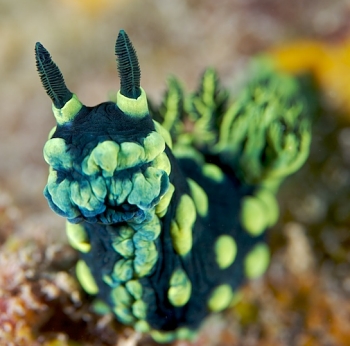
Thanks Bruce,
Bill Rudman
Nembrotha cristata feeding
August 8, 2007
From: Dr. Matt Doggett

Hi,
I have not yet got round to buying a nudibranch book but would really like to know what this one is please? Can anyone help? Initially I thought it was a Chromodoris sp. but now I am not so sure...
Locality: apo Island, 10 m, Philippines, Philippine Sea, Nov 2006, Coral reef. Length: c.a. 4 cm. Photographer: Matt Doggett.
Thanks
Matt
mattdoggett@hotmail.com
Doggett, M.J., 2007 (Aug 8) Nembrotha cristata feeding. [Message in] Sea Slug Forum. Australian Museum, Sydney. Available from http://www.seaslugforum.net/find/20385
Dear Matt,
This is Nembrotha cristata, which is quite similar in shape and colour to N. kubaryana. I have been wondering out loud on the Forum - as I tend to do - whether these two species could perhaps be separated on their choice of food. Like all species of Nembrotha, they feed on ascidians, but from records on the Forum, N. cristata seemed to prefer compound ascidian colonies and N. kubaryana preferred larger species which are either solitary or clumped together. Your photo seems to send that theory to the scrapheap as I am pretty sure this N. cristata is eating the blue solitary ascidian. It is in fact surrounded by these ascidians, which normally favoured by N. kubaryana.
Best wishes,
Bill Rudman
Nembrotha cristata from Malaysia
May 4, 2007
From: Asther Lau
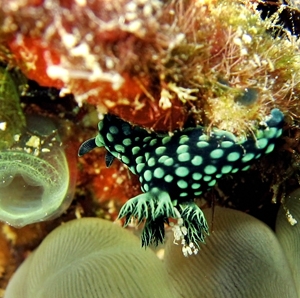
Dear Bill,
Here is another Nembrotha cristata.
Locality: Maki Point, Kapalai Is., Sabah, Malaysia, Celebes Sea. Depth: 14 metres. Length: 2.5 cm. 14 March 2004. Muck divesite. Scattered rocky reef. Photographer: Asther M. Lau
Regards,
Asther M. Lau
asther@astherlau.com
Lau, A, 2007 (May 4) Nembrotha cristata from Malaysia. [Message in] Sea Slug Forum. Australian Museum, Sydney. Available from http://www.seaslugforum.net/find/15441Thanks Asther,
Bill Rudman
Nembrotha cristata & N. kubaryana in Sulawesi
May 3, 2007
From: Mike Krampf

Dear Bill,
I thought I'd share this photo because it shows a Nembrotha cristata & Nembrotha kubaryana in close proximity to each other (assuming I've identified them correctly). I thought it was interesting and thought it may be an good data point for your research.
Locality: Dive Site - Batu Gosok off Bangka Island, 55 ft, Sulawesi, Indonesia, Celebes Sea, 26 October 2006, Reef Wall. Length: 3 cm. Photographer: Mike Krampf.
Mike
mtkrampf@yahoo.com
Krampf, M., 2007 (May 3) Nembrotha cristata & N. kubaryana in Sulawesi. [Message in] Sea Slug Forum. Australian Museum, Sydney. Available from http://www.seaslugforum.net/find/18637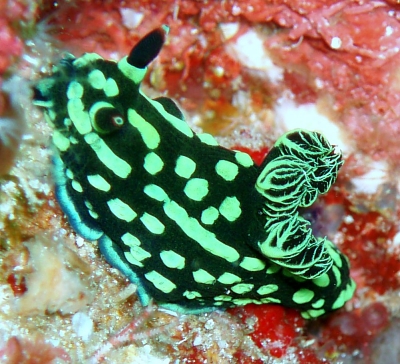
Thanks Mike,
Yes you have identified these species correctly. Certainly N. cristata, without an orange border to the foot, can resemble the more variably coloured N. kubaryana quite closely. As I discuss elsewhere on the Forum, these two species are often found feeding together on the same ascidians, suggesting they may be closely related.
Best wishes,
Bill Rudman
Nembrotha cristata feeding from Raja Ampat
February 6, 2007
From: Mike Krampf

Dear Bill
You have asked for pictures of nudi's "doing things" so thought I'd share these pictures with you. As you can see in the first two pictures, the head of the nudi is buried in the ?? (not sure what it is).
The third picture was taken a few hundred feet down the reef where a group of Nembrotha cristata are clustered on what appears to be the same thing.
Locality: Dive Site - Tanjung Utara off Salawati island, 60 Ft, Raja Ampat, Indonesia, Banda Sea, 26 December 2006, Fringing reef. Length: 3-4 cm. Photographer: Mike Krampf.
Cheers,
Mike
mtkrampf@yahoo.com



Dear Mike,
When I first saw your photos I thought the Nembrotha were feeding on a soft coral with retracted polyps, but if you look carefully at the 'lumps' they are feeding on you will see that the greenish 'blobs' - sorry I can't think of a technical term - are arranged in pairs. I am pretty sure this is a colonial ascidian, and the paired blobs are the retracted inhalent and exhalent siphons which draw water in and pass it out of each individual ascidian. This is also a relief because species of Nembrotha normally feed on ascidians rather than soft corals.
On the Forum you will find photos of N. cristata feeding on Sigillina signifera [messages #2805, #7188] and another ascidian [#8093] which suggests it may feed on a variety of ascidians. Your photos would seem to be of a third species of ascidian. It is a valuable addition to our knowledge of the species.
Best wishes,
Bill Rudman
Nembrotha cristata from Malaysia
October 6, 2003
From: Asther M. Lau

Hi Bill,
Here is an example of Nembrotha cristata.
Site: Malang Rocks, Tioman Is. Malaysia
Depth: 14 meter
Date: 7th Sept 2002
Pics by: Lim Eng Hoo
Regards,
Asther M. Lau
diveworldwide@yahoo.com
Lau, A.M., 2003 (Oct 6) Nembrotha cristata from Malaysia. [Message in] Sea Slug Forum. Australian Museum, Sydney. Available from http://www.seaslugforum.net/find/10957Thanks Asther,
Bill Rudman
Nembrotha cristata from North Sulawesi
October 4, 2002
From: Marli Wakeling
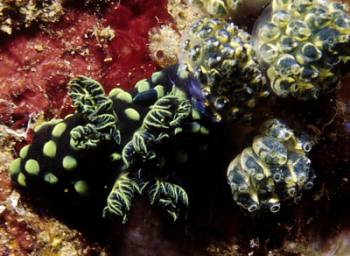
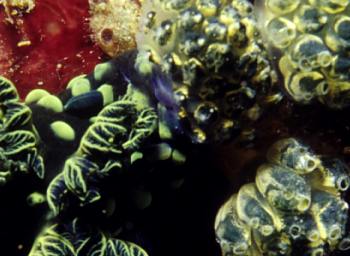
Hi Bill,
Here is Nembrotha cristata eating ascidians. This is from Nudi Falls in Lembeh Straight, Suluwesi, Indonesia.
Location: Nudi Falls, Lembeh Straight, North Suluwesi, Indonesia.
Date: July, 2002
Depth: 30 feet
Length: 5 cm.
Photograph: Marli Wakeling
Regards,
Marli Wakeling
scubamarli@excite.com
Wakeling, M., 2002 (Oct 4) Nembrotha cristata from North Sulawesi. [Message in] Sea Slug Forum. Australian Museum, Sydney. Available from http://www.seaslugforum.net/find/8093Thanks Marli,
I've added a closeup to show the mouth and the ascidians a bit more clearly. It looks a bit different from the usual ascidian it feeds on.
Best wishes,
Bill Rudman
Nembrotha cristata from Indonesia
July 15, 2002
From: Richard Houghton
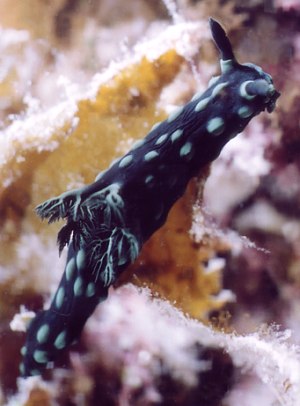
Hi Bill,
I really like the site - it has not only helped me identify some of the delightful creatures in the waters near Singapore, but it continues to inspire me to be vigilant and try to find some new species!
Here is what I think is Nembrotha cristata which I found in the Anambas islands, Indonesia.
Keep up the excellent work!
Rich
richard_houghton@hotmail.com
Houghton, R., 2002 (Jul 15) Nembrotha cristata from Indonesia. [Message in] Sea Slug Forum. Australian Museum, Sydney. Available from http://www.seaslugforum.net/find/7484Thanks Rich,
Yes this is Nembrotha cristata. Glad you like the site. While finding 'new species' can be a thrill, finding new information about existing species is just as exciting and can be done by anyone with eyesight and an interest. Building longer and longer lists of names loses its appeal after a while, specialy when you realise we know almost nothing about the biology and life history of any of these fascinating animals. So keep your eyes open for animals 'doing things' - feeding, breeding, dying, being eaten, swarming etc, etc. The chances are that what you discover will be a new discovery - or at least confirmation of an observation seen by very few before you. I am afraid there are no medals or cash prizes to be won, but it will at least help us to learn a little about our marine environment before, greed, pollution, and other human activities destroy it.
Cheers,
Bill Rudman
Nembrotha cristata feeding
June 12, 2002
From: Erwin Köhler

Dear Bill,
Here is a shot of a feeding Nembrotha cristata from the Philippines, Balicasag Island. During this dive I saw 4 Nembrotha cristata, 5 Nembrotha milleri and 4 Nembrotha kubaryana. Almost all of them feeding on the same kind of ascidian.
Data:
Size 74mm
Depth 17 m
03 March 2002
Erwin
Erwin@medslugs.de
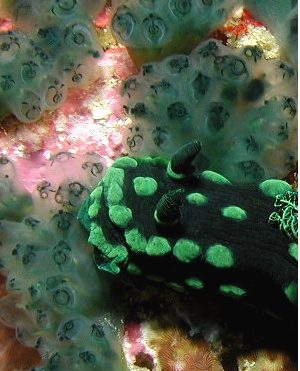
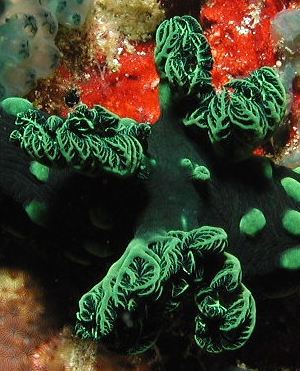
Thanks Erwin,
I have also included a closeup of the gills, not so much to show the gills, but to show the two papillae in the centre of the gill 'circle'. The larger one is the anus, and the smaller one just to the left in the photo (but just anterior in real life) is the kidney opening. The kidney opening is usually very difficult to see in living animals.
Besy wishes,
Bill Rudman
Nembrotha cristata from Bali
February 18, 2002
From: Stuart Hutchison
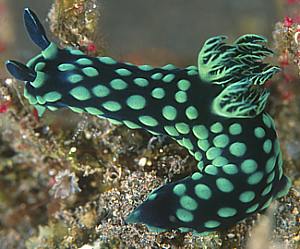
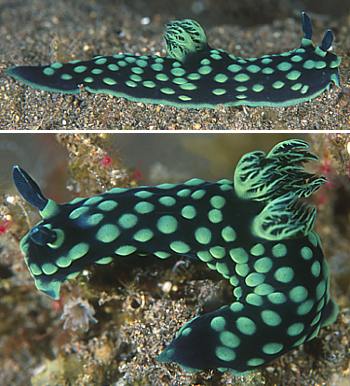
Bill,
This guy was found on the move at 30m on a sandy much diving slope in Bali, Indonesia on 24 Oct 2001. Length was approx 70mm. The tubeworms were not an apparent food source.
Stuart
stuart@stuarthutchison.com.au
Hutchison, S., 2002 (Feb 18) Nembrotha cristata from Bali. [Message in] Sea Slug Forum. Australian Museum, Sydney. Available from http://www.seaslugforum.net/find/6254Thanks Stuart,
No tubeworms are unlikely to be a food source so I guess it was on the search for a mate or more ascidians to eat - or both
Cheers,
Bill Rudman
Nembrotha cristata mating
January 11, 2002
From: Mary Jane Adams

Hi Bill,
I found these two Nembrotha cristata about a meter apart and moved one of them close to the other one. They took an immediate interest in each other and were in such a hurry to mate they didn't even wait to get into the proper position. With penile stylets like this they didn't have to!
Location: Baby Cakes Reef, Florida Group, Solomon Islands.
Best wishes,
Mary Jane
divepng@yahoo.com
Adams, M. J., 2002 (Jan 11) Nembrotha cristata mating. [Message in] Sea Slug Forum. Australian Museum, Sydney. Available from http://www.seaslugforum.net/find/5927Thanks Mary Jane,
Its nice to hear they are so receptive to 'arranged marriages'. I wonder if Nembrotha kubaryana is similarly inclined. Perhaps it wouldn't be too difficult to test some of the different colour 'forms' to see if they are interested in interacting. While it would not be possible to infer anything from lack of interest, a distinct display of interest would strongly suggest they were the same species.
Best wishes,
Bill Rudman
Nembrotha cristata? in the Maldives
December 1, 2001
From: Tim Darters
Can anybody help with an id of a specimen i saw whilst snorkeling in the maldives. It was on coral about 4m down and was simply black with vivid green blotches -almost stripes.It was probably no more than 35mm long. I took a photo but it was poor. Directions to a pic would be great. The reef was Velidhu.
Thanks,
Tim Darters
tim.darters@virgin.net
Darters, T., 2001 (Dec 1) Nembrotha cristata? in the Maldives. [Message in] Sea Slug Forum. Australian Museum, Sydney. Available from http://www.seaslugforum.net/find/5724Dear Tim,
Your animal could possibly be Nembrotha cristata or Nembrotha kubaryana which are two similarly coloured species with a somewhat variable colour pattern. Have a look at the various photos on the Forum
Best wishes,
Bill Rudman
Is this Nembrotha kubaryana?
June 27, 2001
From: Asther M. Lau
Hi there,
I've recently encountered a nudibranche which looked pretty much like Nembrotha kubaryana. The confusion came in when I realised that the whole body is only green. It has 3 bushes of gills. And the green dots is slightly bulging out from its body.
The pics I seen on the species list are very common with black body and green dots. But the one I found at Sea Fan Garden which is in Tioman Island of Malaysian waters is all green. When I saw it, it was feeding on a type of ascidians as well. And it was about 5cm long.Could this be another Kubaryana? Do let me know.
Thank you.
Asther
diveworldwide@yahoo.com
Lau, A.M., 2001 (Jun 27) Is this Nembrotha kubaryana?. [Message in] Sea Slug Forum. Australian Museum, Sydney. Available from http://www.seaslugforum.net/find/4546Dear Asther,
Some of these species are quite variable in colour so I am only guessing wthout a photo. It could be N. kubaryana but if there was no orange on the rhinophores or the edge of the foot then it was possibly Nembrotha cristata. Both species usually have a black background colour but it can at times appear as a dull dark green.
Best wishes,
Bill Rudman.
Nembrotha cristata from SE Sulawesi
April 10, 2001
From: Lindsay Warren
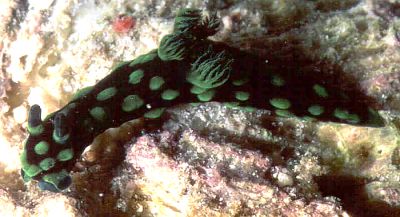
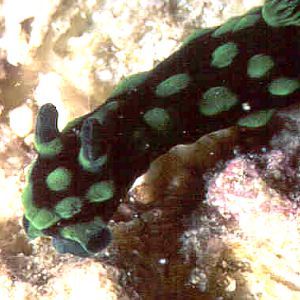
Dear Bill
Some time ago you asked if I could send a shot of a 'regular' Nembrotha cristata found in the Tukang Besi Archipelago, SE Sulawesi in connection with Nembrotha cf. cristata (OS0851).
I have attached a shot of OS0561 which was found on 27 July 1999 by Dean Lea on Pulau Hoga at a depth of 13.7m on a tunicate (no indication of what type). Size: 27 mm. Photo: Lindsay Warren.
Hope this is of interest.
All the best
Lindsay
alldcl@compuserve.com
Warren, L., 2001 (Apr 10) Nembrotha cristata from SE Sulawesi. [Message in] Sea Slug Forum. Australian Museum, Sydney. Available from http://www.seaslugforum.net/find/4132Thanks Lindsay,
It's certainly helpful to see extra photos.
Best wishes,
Bill Rudman
Nembrotha cristata from Solomon Ids
August 3, 2000
From: Mary Jane Adams
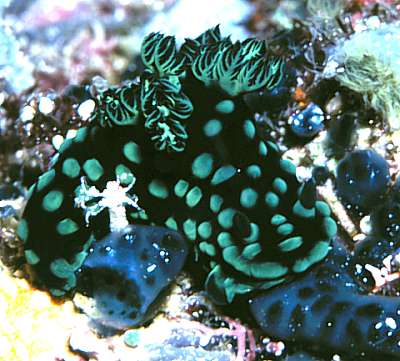

Dear Bill,
Here is a picture of Nembrotha cristata on a possible prey item (UPPER PHOTO). The other image shows the same nudibranch from a different angle. Is it my imagination or does this slug have two complete sets of gill plumes?
Crawling length 50 mm
Depth 10 meters
Divesite="Baby Cakes", aka "Velvia" (same reef as images of N. milleri) Florida Group, Solomon Islands, November, 1999
Regards,
Mary Jane
mjadams@earthlink.net
Adams, M.J., 2000 (Aug 3) Nembrotha cristata from Solomon Ids. [Message in] Sea Slug Forum. Australian Museum, Sydney. Available from http://www.seaslugforum.net/find/2805Dear Mary Jane,
Thanks for the great photos. It certainly looks like it has 2 sets of gills in your photos. The dorid nudibranchs are divided into two Superfamilies, the Anadoridoidea (Phanerobranchia) and Eudoridoidea (Cryptobranchia), the names in parentheses being alternative names for the groups. These alternative names are based on the major external character, the Eudoridoidea having gills which can retract and hide in a special gill pocket, while the Anadoridoidea have 'naked gills' with nowhere to hide.
Nembrotha belongs to the Anadoridoidea and the gills do not retract into a pocket. When smaller there are usually three main trunks but as they grow each trunk branches. At the same time the basal attachment point of each trunk to the blood supply begins to move apart as the animal grows. Eventually the three main trunks appear to be three separate branching gills. There is usually a major gill in the midline just in fromt of the anal papilla and a smaller gill on each side, just behind the anus. I suspect in your photos the left posterior gill in the upper photo is hidden because of the angle of the photo. In the lower photo I think I can see one branch of the posterior right gill just behind the left posterior gill.
Best wishes,
Bill Rudman
Nembrotha cristata from Papua New Guinea
July 8, 1999
From: Grey McNeil
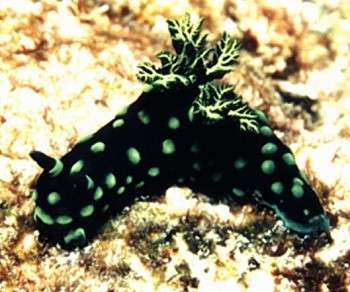
Dear Bill,
Could you identify this photo please. The details are:
HOUSE REEF, JAIS ABEN, Papua New Guinea. 3m, 5cm long, December 1998.
Thanks,
Grey McNeil.
GREYMACIND@bigpond.com
McNeil, G., 1999 (Jul 8) Nembrotha cristata from Papua New Guinea. [Message in] Sea Slug Forum. Australian Museum, Sydney. Available from http://www.seaslugforum.net/find/995Dear Grey,
This is Nembrotha cristata. It is very similar in colour to one of the forms of Nembrotha kubaryana differing mainly in the absence of any orange colouration. If you ever get the chance it would be useful to get some biological information on these animals - about their egg masses and what food they eat etc. Photos are a good way amateurs can help to build up our knowledge about marine life. It would be foolish to say Species 'X' eats sponge 'Y' just because we have one photo of it sitting on the sponge, but if over a number of years we only have photos of it associated with a particular sponge, or in the case of a Nembrotha, a particular ascidian (sea squirt), then we can be pretty sure there is a connection between the two.
Bill Rudman.
Rudman, W.B., 1999 (Jul 8). Comment on Nembrotha cristata from Papua New Guinea by Grey McNeil. [Message in] Sea Slug Forum. Australian Museum, Sydney. Available from http://www.seaslugforum.net/find/995Nembrotha cristata from the Philippines
January 21, 1999
From: Erwin Koehler

Bill,
Here is Nembrotha cristata (Bergh, 1877), Housereef, Panglao Is., Philippines, Nov. 1998
Erwin
E.Koehler@deutschepost.de
Koehler, E., 1999 (Jan 21) Nembrotha cristata from the Philippines. [Message in] Sea Slug Forum. Australian Museum, Sydney. Available from http://www.seaslugforum.net/find/495